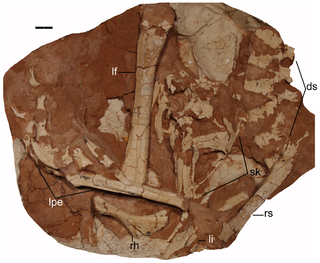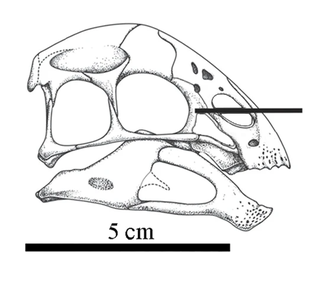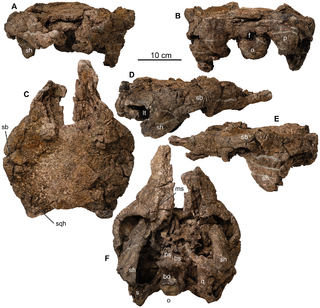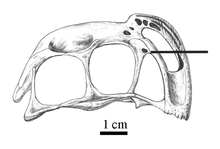
Nemegtomaia is a genus of oviraptorid dinosaur from what is now Mongolia that lived in the Late Cretaceous Period, about 70 million years ago. The first specimen was found in 1996, and became the basis of the new genus and species N. barsboldi in 2004. The original genus name was Nemegtia, but this was changed to Nemegtomaia in 2005, as the former name was preoccupied. The first part of the generic name refers to the Nemegt Basin, where the animal was found, and the second part means "good mother", in reference to the fact that oviraptorids are known to have brooded their eggs. The specific name honours the palaeontologist Rinchen Barsbold. Two more specimens were found in 2007, one of which was found on top of a nest with eggs, but the dinosaur had received its genus name before it was found associated with eggs.

Nanshiungosaurus is a genus of therizinosaurid that lived in what is now Asia during the Late Cretaceous of South China. The type species, Nanshiungosaurus brevispinus, was first discovered in 1974 and described in 1979 by Dong Zhiming. It is represented by a single specimen preserving most of the cervical and dorsal vertebrae with the pelvis. A supposed and unlikely second species, "Nanshiungosaurus" bohlini, was found in 1992 and described in 1997. It is also represented by vertebrae but this species however, differs in geological age and lacks authentic characteristics compared to the type, making its affinity to the genus unsupported.

Zhongyuansaurus is a monospecific genus of ankylosaurid dinosaur from Henan that lived during the Early Cretaceous in what is now the Haoling Formation. Zhongyuansaurus is possibly a junior synonym of Gobisaurus, a basal ankylosaurid from the Ulansuhai Formation of Inner Mongolia.

Ceratonykus is a monospecific genus of alvarezsaurid dinosaur from Mongolia that lived during the Late Cretaceous in what is now the Barun Goyot Formation. The type and only species, Ceratonykus oculatus, is known from a fragmentary skeleton, including an incomplete skull, of an adult individual. It was named and described in 2009 by Vladimir Alifanov and Rinchen Barsbold. Its describers questioned the traditional placement of alvarezsaurs in Theropoda, instead suggesting they were ornithischians, but this has not been accepted since. Ceratonykus has an estimated length of 75 centimetres and weight of 760 grams. It has been considered as a possible junior synonym of Parvicursor.

Shaochilong is an extinct genus of carcharodontosaurid dinosaur from the mid-Cretaceous Ulansuhai Formation of China. The type species, S. maortuensis, was originally named Chilantaisaurus maortuensis, but was re-described and reclassified in 2009. It was one of the last known carcharodontosaurids to walk the earth. Alongside Mapusaurus from Argentina, they were the only members of the family to live until the end of the Turonian epoch.

Zuolong is an extinct genus of tetanuran theropod from the Late Jurassic period of China. The type and only species is Z. salleei. The generic name of Zuolong is in honor of General Zu Zōngtáng with the Chinese word "long" which means dragon. The specific epithet "salleei" is in honor of Hilmar Sallee, who funded the expedition which led to the specimen's discovery.

Linhevenator is a genus of short-armed troodontid theropod dinosaur from the Late Cretaceous (Campanian) Bayan Mandahu Formation of Bayan Mandahu, Inner Mongolia, China.

Yulong is an extinct genus of derived oviraptorid theropod dinosaur known from the Late Cretaceous Qiupa Formation of Henan Province, central China. It contains a single species, Yulong mini. It is known from many juvenile specimens that represent some of the smallest known oviraptorids and also a single subadult specimen.

Jianchangosaurus is a genus of therizinosaurian dinosaur that lived approximately 126 million years ago during the early part of the Cretaceous Period from the Yixian Formation in what is now China. The nearly complete juvenile specimen was missing only the distal tail. Jianchangosaurus was a small, lightly built, bipedal, ground-dwelling herbivore, that could grow up to an estimated 2 m (6.6 ft) long and was 1 m (3.3 ft) high at the hips.

Jiangxisaurus is an extinct genus of oviraptorid theropod dinosaur from the Late Cretaceous Nanxiong Formation of southern China. It was similar to Heyuannia, but with more strongly curved anterior claws and a thinner, frailer mandible. This find is paleontologically significant because it contributes to current knowledge about the paleogeographical distribution of oviraptorids in southern China. It was most likely an omnivorous animal along with its close relatives Nankangia and Ganzhousaurus.

Nankangia is an extinct genus of caenagnathoid oviraptorosaurian dinosaur known from the Upper Cretaceous Nanxiong Formation of Nankang County, Ganzhou City of Jiangxi Province, southeastern China. It contains a single species, Nankangia jiangxiensis. N. jiangxiensis coexisted with at least four other caenagnathoids, including but not limited to Corythoraptor, Banji, Ganzhousaurus and Jiangxisaurus. The relatively short dentary and non-downturned mandibular symphysis of Nankangia suggest that it may have been more herbivorous than carnivorous. Its diet consisted of leaves and seeds.

Europelta is a monospecific genus of nodosaurid dinosaur from Spain that lived during the Early Cretaceous in what is now the lower Escucha Formation of the Teruel Province. The type and only species, Europelta carbonensis, is known from two associated partial skeletons, and represents the most complete ankylosaur known from Europe. Europelta was named in 2013 by James I. Kirkland and colleagues. Europelta has an estimated length of 5 metres and weight of 1.3 tonnes, making it the largest member of the clade Struthiosaurini.
This glossary explains technical terms commonly employed in the description of dinosaur body fossils. Besides dinosaur-specific terms, it covers terms with wider usage, when these are of central importance in the study of dinosaurs or when their discussion in the context of dinosaurs is beneficial. The glossary does not cover ichnological and bone histological terms, nor does it cover measurements.

Mosaiceratops is a genus of ceratopsian, described by Zheng, Jin & Xu in 2015 and found in the Xiaguan Formation of Neixiang County. Mosaiceratops lived in the upper Cretaceous in what is now the Henan Province of China.

Tongtianlong is a genus of oviraptorid theropod dinosaurs that lived in the late Maastrichtian epoch of the late Cretaceous period. It contains one species, T. limosus.

Zhongjianosaurus is a genus of dromaeosaurid belonging to the Microraptoria. Believed to hail from the Yixian Formation, specifically the middle of the Jehol Biota, it is the smallest known microraptorine thus far discovered and one of the smallest non-avian theropod dinosaurs.

Jianianhualong is a genus of troodontid theropod dinosaur from the Early Cretaceous of China. It contains a single species, Jianianhualong tengi, named in 2017 by Xu Xing and colleagues based on an articulated skeleton preserving feathers. The feathers at the middle of the tail of Jianianhualong are asymmetric, being the first record of asymmetrical feathers among the troodontids. Despite aerodynamic differences from the flight feathers of modern birds, the feathers in the tail vane of Jianianhualong could have functioned in drag reduction whilst the animal was moving. The discovery of Jianianhualong supports the notion that asymmetrical feathers appeared early in the evolutionary history of the Paraves.

Corythoraptor is a genus of oviraptorid dinosaur from the late Maastrichtian Nanxiong Formation of South China. It contains one species, C. jacobsi, known from a single well-preserved skeleton, and named after paleontologist Louis L. Jacobs. It bears a tall crest similar to that of the modern cassowary, and possibly had a similar functionality of display and resonance to detect lower-frequency sounds.

Dynamoterror is a monospecific genus of tyrannosaurid dinosaur from New Mexico that lived during the Late Cretaceous in what is now the upper Allison Member of the Menefee Formation. The type and only species, Dynamoterror dynastes, is known from a subadult or adult individual about 9 metres long with an incomplete associated skeleton. It was named in 2018 by Andrew T. McDonald, Douglas G. Wolfe and Alton C. Dooley, Jr. Dynamoterror was closely related to Teratophoneus and Lythronax.

Spectrovenator is a genus of basal abelisaurid theropod dinosaur that lived during the early Cretaceous period in what is now Brazil. It is known by a single species, S. ragei, recovered from the Quiricó Formation.





















